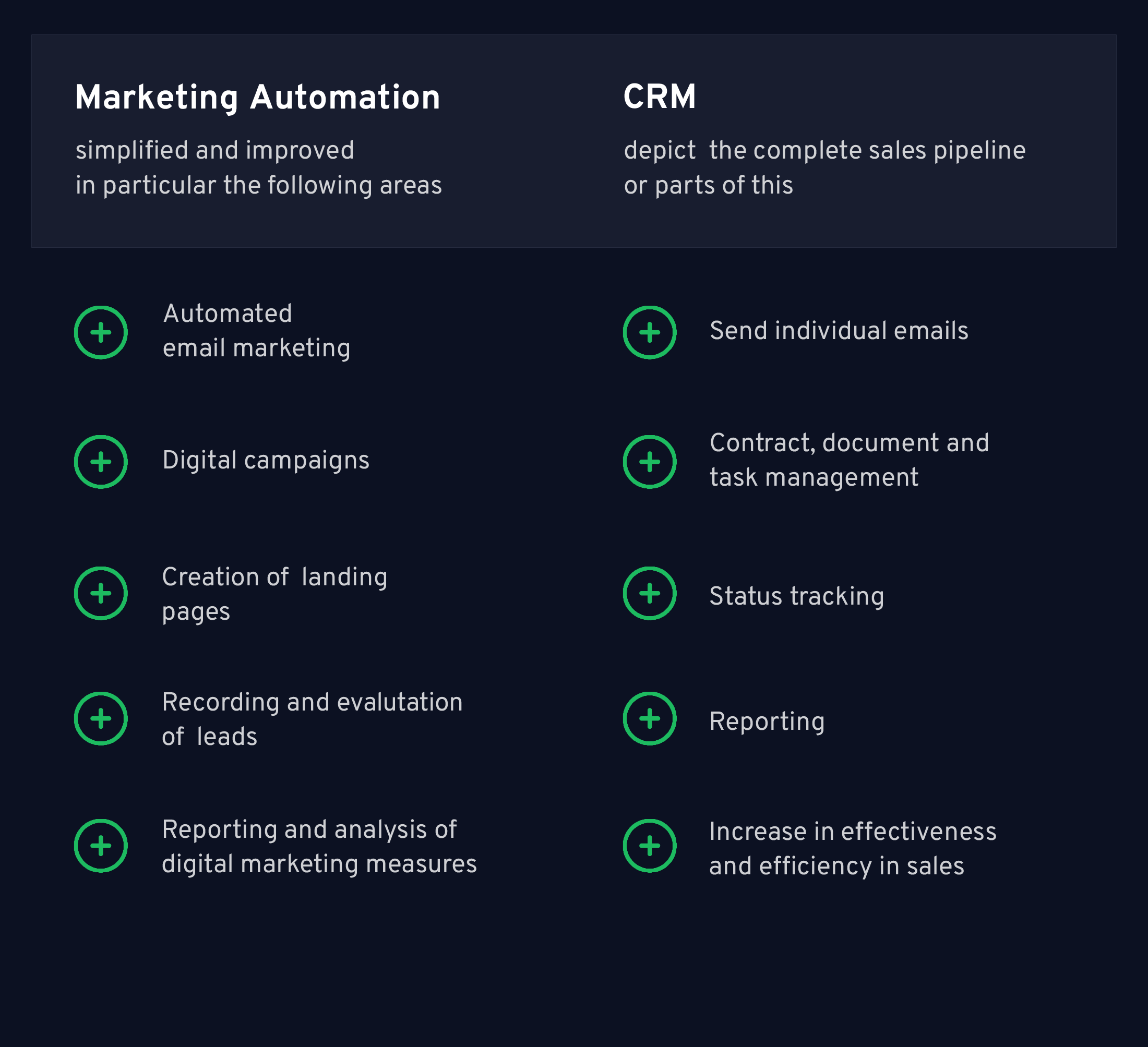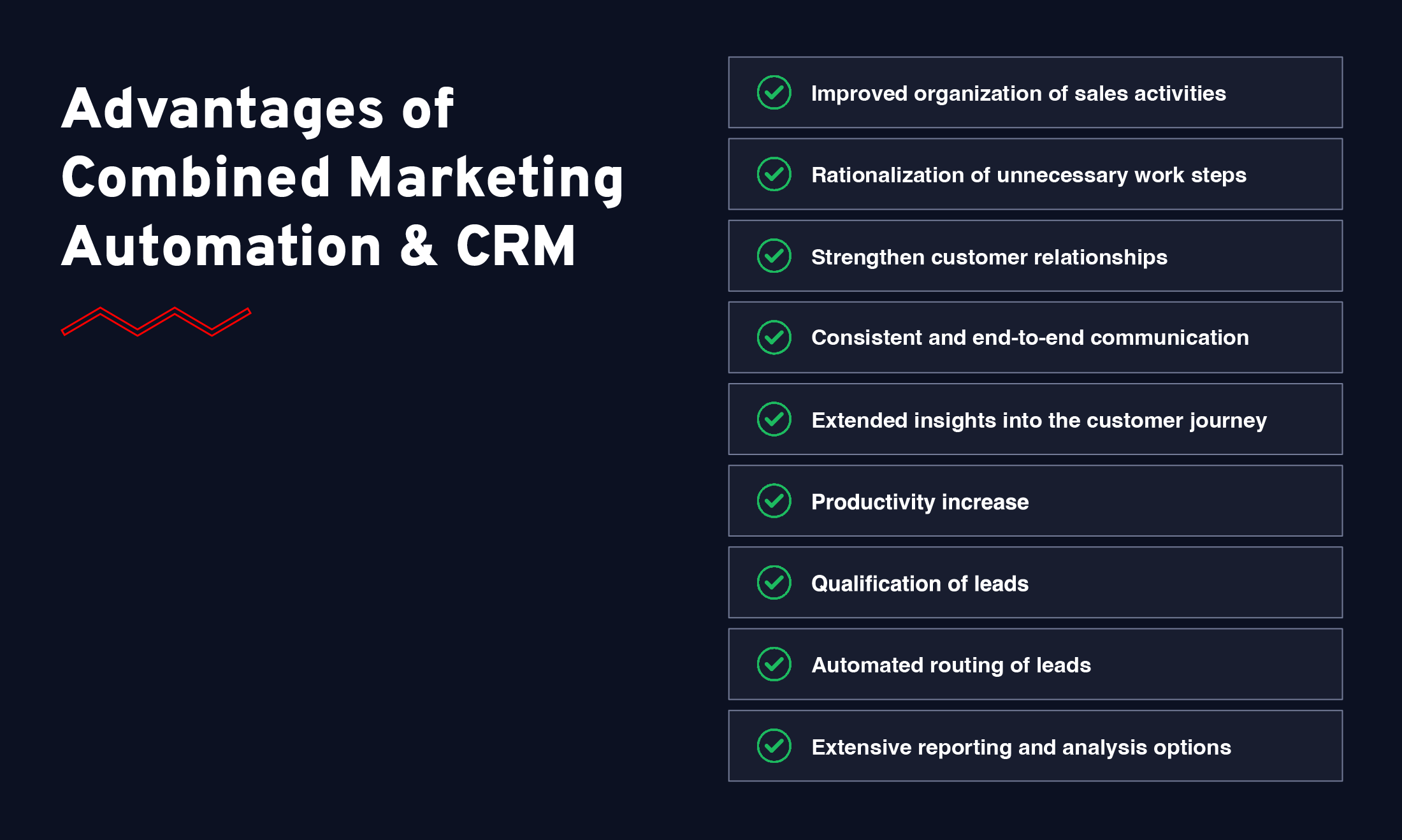
Autorin
Katharina Krug
CEO & Founder
Table of Contents
Share the article now!
DE
EN
DE
EN

Autorin
CEO & Founder
Modern companies can hardly do without CRM and Marketing Automation. But where do the boundaries actually lie, and where do they blur? How can both systems be combined and the optimum results be achieved? Find out all the answers in this article.
CRM and Marketing Automation - strong on their own, even stronger in a double pack. This image can also be transferred to sales and marketing, because both tools symbolize this.
Sales and marketing are among the most important areas of the company and make a significant contribution to the company's continued existence and growth. No business can exist without sales and revenue. And although both areas only develop their full strength in combination, they are usually viewed and treated in isolation.
This is exactly where the integration of CRM and Marketing Automation comes into play. The link makes it possible to automate processes, increase efficiency and effectiveness, relieve employees and increase customer satisfaction.
Practical application examples are: upsell & cross-sell, personalized marketing campaigns, simplified data maintenance, reactivation of inactive customers, mapping of the entire customer journey and extensive reporting options.
In order for the integration to succeed, careful planning and a well thought-out approach are required. Once the link is complete, your marketing and sales processes will reach a new level. The rewards are happier customers, more efficient employees and growth in sales.
CRM is the abbreviation for Customer Relationship Management and symbolizes the customer-oriented orientation of a company. CRM systems map the entire sales chain. From the initial meeting to maintaining customer relationships and service to contract management and contact management.
Furthermore, important customer information such as, e.g., phone numbers, addresses, call notes and purchase data are stored centrally. This greatly simplifies the day-to-day work of the sales team.
A CRM software forms the basis for the measurability, optimization and centralization of sales processes and bundles all essential activities in one place. They make it possible to optimize interactions with customers, increase customer satisfaction, streamline processes and, last but not least, increase sales.
It is important to mention that this is not an enterprise resource planning system. You can learn the difference between the software solutions here: CRM & ERP.
David Ferguson (Executive Director of Babel Academy of English)
With the help of marketing automation, repetitive processes are recorded and automated using algorithms. Essentially, it is about digitizing previously analog processes. Modern marketing automation tools link and optimize various areas of the company, e.g. Marketing, Customer Service and Web Development - also Sales Automation.
The intelligent tools can automatically record, evaluate, qualify and divide new leads into individual target groups. You are able to cover the entire customer journey. This makes it possible to place suitable content in all phases of the customer journey and to accompany the prospect to the desired conclusion.
Marketing automation not only ensures happier customers, but also significantly increases the conversion rate and Return on Investment.
CRM software and marketing automation tools look very similar at first glance, especially for the inexperienced. But despite the many overlaps, they serve two different purposes in their respective origins.
For the best possible results, it is important to know the differences and to have the actual goal of each software in mind. The tools develop their full power when they are combined with each other and supplement the respective deficits. But more on that later.
The main difference between CRM and marketing automation tools is that the former are mainly used for Sales, Customer Care and Service and the latter for Marketing.

CRM, on the other hand, maps the entire sales pipeline or parts of it. Typical functions include:
So while CRM mainly facilitates and optimises day-to-day sales work, Marketing Automation contributes significantly to the generation and maintenance of leads. And it is precisely at this point that both systems ideally play into each other's cards.
CRM and Marketing Automation support each other and cover the gaps of the other tool. By linking them, you can maximise the performance of each tool and make your own day-to-day work much easier. Sales and marketing no longer work side by side but with each other.
Data can be synchronised automatically instead of being transferred manually. This drastically reduces the error rate and saves an immense amount of work. Your customer communication, marketing campaigns and sales efficiency will also improve significantly.

Here are some of the advantages of the combination:
In particular, the enhanced communication capabilities will significantly increase your productivity. Instead of addressing customers in a differentiated manner, marketing and sales can network much more efficiently with the help of the combined tools and coordinate their approach in a uniform manner.
Area A always has an overview of the activities of area B and vice versa. Transparency is thus increased many times over. This not only enables a more targeted approach to customers but also reduces unnecessary and duplicated work.
Before starting directly with the integration, you should plan it carefully beforehand. This will save you a lot of effort, time and trouble later on. More on this in the next section.
The technical linking of CRM and Marketing Automation is an extensive topic that requires a separate article. At this point, however, we would like to give you the most important tips:
The connection of two such complex systems requires some preparation. Check your marketing and sales activities in advance and be aware of which processes need to be supplemented and optimised. It also helps to define goals, necessary implementation steps and deadlines. The more precisely you plan in advance, the cheaper and more efficient the actual implementation will be.
In the course of the implementation measures, you should ensure that duplicate data is eliminated directly. This will avoid inconsistencies, problems and workload later on.
You can also think in advance about which data should be transferred automatically when the integration starts. This way, important information such as customer data, business partners, sales volume and recent contacts can be automatically transferred to your marketing automation tool, eliminating a lot of tedious work.
Personalisation of the customer journey can also be done at this stage, with data such as names, birthdays, and previous purchases automatically transferred between systems.
In most cases, integration is not completed in one go. Rather, it requires ongoing adjustments and constant optimisation over the next few days and weeks. However, once these efforts are complete, the numerous benefits of integration await you.
Linking CRM and Marketing Automation makes it noticeably easier to maintain customer data. Among other things, duplicate entries can be easily removed, conversation notes added, and contact data updated. The systems synchronise automatically and thus avoid duplicate work.
This point is also of great importance in the area of B2B Marketing Automation. Leads can be maintained with important information such as industry, number of employees, region or sales volume. The profiles can then be selected according to certain criteria and addressed precisely by marketing and sales activities. This prevents wastage and enables more efficient closing rates.

Thanks to the data provided, marketing and sales activities can be efficiently coordinated. For example, you can automatically send discount vouchers for the next purchase as soon as an order arrives. Or you can offer free shipping for orders over a certain quantity. Thanks to the integration, you can encourage satisfied buyers to upsell or cross-sell and noticeably increase the customer lifetime value.
A subscription model is also conceivable for many products and services. In this way, automated orders can be triggered in a fixed time rhythm. In addition to the customer's consent, this requires a corresponding data flow. CRM and marketing automation form the perfect basis for this.

Who doesn't enjoy birthday wishes, Christmas greetings and other nice gestures? Celebrate special events with your customers. With the help of automation, you can send personalised messages along with occasion-related congratulations and vouchers.
Company anniversaries, anniversaries or all holidays are also great occasions to send automated emails. You can let your creativity run free (a professional Email Marketing Agency will be happy to help). Do you know, for example, the International Day of Italian Cuisine? It is celebrated on 17 January and offers a great hook for all restaurateurs or for the next business lunch with your favourite customer.

Does it also annoy you when you talk to different employees of a company and have to start all over again each time? This is not only annoying but also damaging to customer relations. Centralising information enables transparent communication between different departments. One face to the customer.
This means that Employee A is always aware of the contact between Customer X and Employee B. This enables a seamless workflow and significantly improved customer communication. Not only will your customers thank you, but also your employees. After all, this procedure reduces the workload and saves unpleasant justifications.

Your customer hasn't bought anything for a while? Then draw attention to yourself! Thank them for their long-term loyalty with personalised e-mails and reactivate your customer with discounts, free shipping campaigns or product samples.
Your customer may have been about to place an order anyway before something came up in his or her daily routine. A little reminder comes in handy in these cases. And who knows - maybe the shopping basket will be filled again thanks to the discount.

Thanks to linking CRM and Marketing Automation, you can seamlessly analyse and evaluate the entire marketing and sales process. This allows you to see exactly where things are already going well and where there is still room for improvement. Important decisions can be made based on data and facts instead of having to rely on gut feeling.
Data is the new gold and the basis for optimised processes. It enables you to discover highly lucrative leads and thus push your sales figures forward. Your customers also benefit from optimised marketing campaigns. After all, they are no longer randomly bombarded with advertising, but get to see content that really interests them. A win-win situation for all involved.

The richer the information about a lead is, the more valuable and qualified a lead becomes. Instead of sending your sales team directly to new leads, these can first be automated with content and then further qualified. This allows your salespeople to focus on the most promising leads and convert them into paying customers.
This does not mean that the remaining leads are disregarded. On the contrary, thanks to the linking of CRM and marketing automation, your contacts are automatically accompanied through the individual phases of the customer journey. Accordingly, previously "cold" leads are "warmed up" more and more until they are finally qualified for personal contact.

Aaron Levie (CEO & Found of Box)
By now, you should be aware of the advantages of linking CRM and Marketing Automation. The only question that remains to be explained is: How can you actually get started?
Sounds obvious at first, but it's not. There are many different CRM and marketing automation tools on the market. All of them have their individual advantages and disadvantages. But not every software is suitable for every project and every company situation.
So, the first step is to inform yourself thoroughly and weigh up the strengths and weaknesses of the individual tools. Thanks to our many years of experience, we know numerous providers from practical experience and will be happy to support you in your selection.
As already described, you should not start headlong with the integration but plan it carefully. Involve marketing and sales as well as other departments such as customer service.
Even the best plan must be put into action at some point in order to bear fruit. Many challenges and requirements only emerge during implementation. So be flexible and prepared for obstacles. Last but not least, it is important to constantly optimise both systems and coordinate them with each other. This way, you can achieve the best possible results.
We accompany you both in an advisory and operative capacity, from the acquisition to the optimisation of your tools. All this is only possible because we act as both a CRM agency and a marketing automation agency. In this way, you get the best possible results from your systems and take your marketing and sales processes to the next level.
CRM systems and marketing automation tools are already very powerful and efficient tools in their own right. However, they only unfold their full power in interaction. The integration of both systems is complex, and there are a number of points to consider.
However, once the linkage is complete, numerous advantages beckon. Both your marketing and your sales will be enormously promoted. Your employees are freed from superfluous tasks and can concentrate on the essentials.
You can address customers in a much more targeted and efficient manner and drastically increase customer satisfaction. The result is increased sales, more productive employees and long-term customer relationships.
If you need support with the integration, feel free to contact us. We are experts in both CRM and marketing automation and know how to get the best out of both worlds.

About the author
A suitable strategy is needed for CRM to succeed. It is necessary to ensure that customer relationships are successfully managed and lived in the company.
ERP & CRM form the basis of a digitalised company. In this article, you will learn what is behind these terms, which factors need to be taken into account when introducing them, and how they can help...
Recently, kkvision implemented a comprehensive digitization project with the catering company Last Exit, from which the company benefited greatly right from the start. Find out here how a catering...